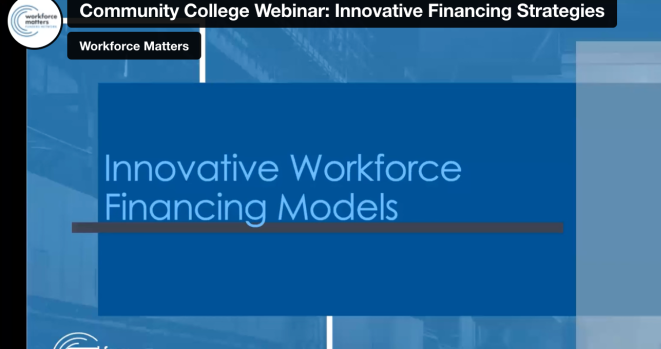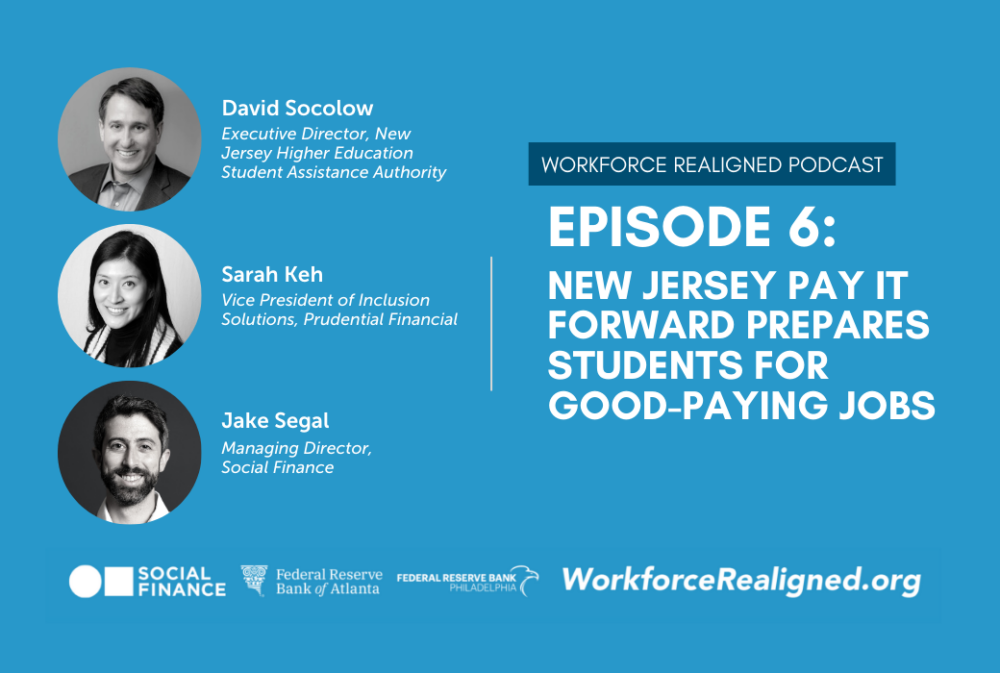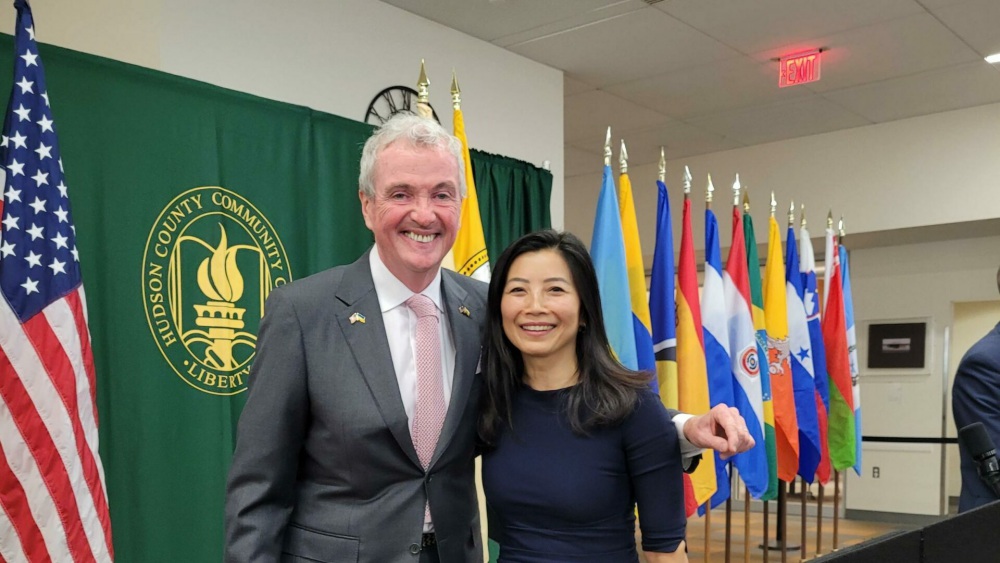

Workforce & Education Investments, Workforce & Economic Mobility, Pay It Forward Funds, Financing Tuition & Living Expenses
On Thursday, September 21, 2023, Workforce Matters hosted our second virtual learning and discussion series on community colleges and workforce development. Featuring the New Jersey Pay it Forward Program, the conversation explored how innovative workforce financing–whether designed to provide last-dollar funding, or invested to stretch or amplify impact–might serve community colleges exploring outcomes-based financing.
Our featured panelists included:
- Heather Devries, Ph.D., Dean, Academic Affairs and Assessment | Accreditation Liaison Officer, Hudson County Community College
- Susan Dundon (former) Director, Young Adults and Working Families, Ralph C. Wilson, Jr. Foundation
- Jake Edwards, Vice President, Impact Investments, Social Finance
- Ronit Kanwar, Director, Schmidt Futures
Jake Edwards began the conversation by providing background information about the New Jersey Pay It Forward Program and Pay It Forward Funds, which are place-based workforce funds that sustainably invest in worker upskilling by recycling funds to ‘pay it forward’ for future learners, furthering the impact of public and philanthropic dollars. Spearheaded by the Governor’s office and in partnership with numerous state agencies and corporate philanthropies, the NJ Pay It Forward Program launched in fall 2022 with 100 learners enrolled in programs for nursing, welding, HVAC, and cybersecurity. A total of $15 million in funding was made available to learners at three partner local institutions: Hudson County Community College, Camden County Community College, and the New Jersey Institute of Technology.
This last-dollar in program avails zero-interest, no-fee, outcome-based loans to learners to cover funding gaps for tuition, exam fees, equipment and supplies, transportation, and tutoring. Learners can also access non-repayable living stipends for mental health support, emergency fund support, and childcare subsidies, among other needs. After program completion, if the learner obtains employment paying above a specified threshold, they make payments back to the fund which are recycled and reinvested to provide support to future students to pay it forward.
The sustainability of innovative financing strategies like NJ Pay It Forward, in which current a participant’s success enables more students to participate and succeed, can be appealing to funders. As Susan Dundon shared, for a spend-down foundation like the Ralph C. Wilson, Jr. Foundation, these investments appealed to their trustees who are considering their legacy and lasting impact.
Additionally, this model aligns incentives across all stakeholders–beneficiary, funder, and providers. As Ronit Kanwar shared, the last-dollar in program design ensures that all other available resources are first being utilized, and that funding can be stretched to maximize every dollar for greater impact–especially when in coordination with other community college grantmakers. In addition, overhead and transaction costs decrease as more funds are set-up and can leverage the infrastructure and systems already in place. Indeed, the NJ Pay It Forward Program is already planning to expand, and planning for the Western NY Pay it Forward Fund is underway to offer learners in that region expanded access to programs in IT and skilled trades pathways.
Advice for Funders
Here are some questions, considerations, and things to keep in mind when exploring innovative financing strategies for community colleges:
- Partnerships are essential.
This work benefits from having as many stakeholders at the table as possible.
- Internal partners and stakeholders within the institution (e.g., Dean’s Office, Academic Affairs, Student Affairs, Financial Aid, Workforce Development/Job Placement, Other departments)
- Ecosystem player / social financier / field strategist helpful for insight, coordination, and resources
- Field partners to bring in the right training providers, design programs
- State and city/local leaders
- Corporate partners
- Philanthropies
- Understand the problem, and know your “why.”
Bring together the stakeholders to first narrowly define the problem–don’t start with the tool. Identify what is preventing more students from enrolling, or limiting the potential or outcomes for learners who are enrolled. Is there a gap around student or financial support? Issues surrounding job placement or insufficient employer partners? Is the program addressing the labor market needs that exist in the community?
Success requires an open and transparent conversation across all stakeholders about what the objectives are, and what resources are at your disposal. For NJ Pay It Forward, stakeholders committed to optimizing for student success and friendliness, even though that resulted in fewer funds being “recycled” for future cohorts.
- Consider the role of employers.
Employers are used to being talent consumers, but they can also be involved as financial contributors, investing into, and hiring out of, programs. The benefit to employers is a diversified and larger workforce of well-trained employees. Dr. Heather Devries of Hudson County Community College shared that this program has amplified interest from employers in hiring students. They have excellent job placement outcomes, and one of the funders of the program is actively hiring participants.
- Support learners in- and outside of the classroom.
The secret sauce is in the holistic support services provided to participants. Of course, each region will vary by program modality, services, providers, etc., but ultimately the goal is to meet the needs of the target population being served. Some examples include:
- Access to emergency funding
- Access to case management
- Instructional support during the technical phase of a program
- Opt-in living stipend that is repayable, contingent upon successful completion
- Non-repayable living stipend
Looking to learn more? You can view a recording of the full conversation on the Workforce Matters Funders Network website.
Related Insight

Workforce Realigned Podcast, Episode 6: New Jersey Pay It Forward Prepares Students for Good-Paying Jobs
In this Workforce Realigned podcast episode, David Socolow, Executive Director of the New Jersey Higher Education Student Assistance Authority, Sarah Keh, Vice President of Inclusion Solutions at Prudential Financial, and Social Finance’s Jake Segal, discuss…

Case Studies: New Approaches to Financing Education and Training
The case studies explore three of our economic mobility partnerships—the American Diesel Training Centers Career Impact Bond, the Google Career Certificates Fund, and the New Jersey Pay It Forward Program—and highlight the unique program design,…

New Jersey Pay It Forward Program Launch Event
Hudson County Community College hosted a launch event for the New Jersey Pay It Forward Program, a joint initiative of Governor Phil Murphy, the State of New Jersey, New Jersey CEO Council, and Social Finance.